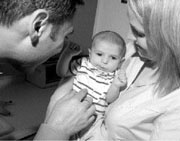EIGHT DAYS AFTER Julia Aliabadi gave birth to a baby boy with big brown eyes, she noticed him breathing so heavily that he sounded like a creaky door. She and husband Houman took baby Loucas to the emergency room at Children’s Hospital and Medical Center, where, Julia says, “the bomb dropped.” Doctors told the Aliabadis that their son’s heart had an essentially nonfunctioning left ventricle, a congenital defect that would likely require a complicated and risky multistage procedure called the Norwood.
Children’s has been performing the Norwood for years. But in March, when the Aliabadis brought Loucas in, doctors told the family that the hospital couldn’t perform the procedure and it would have to send the family to San Francisco.
What the Aliabadis didn’t know is that two months prior, the hospital’s chief heart surgeon, Flavian Mark Lupinetti, had walked off the job following a controversy of operatic proportions involving feuding doctors, questions over quality of care, and the hospital’s use of private investigators to find an anonymous letter writer making accusations of surgical mistakes (that were never proven). Given Lupinetti’s departure, the prestigious hospital’s heart center has drastically curtailed its operations and is now in the middle of a recruitment drive for a new surgeon.
Lupinetti’s exit was “not unexpected” but abrupt, says Edward Verrier, the University of Washington’s chief of cardiothoracic surgery who is responsible for all of the heart programs affiliated with the university, including Children’s. Lupinetti literally came in one day and said, “I’m leaving tomorrow,” Verrier recalls.
A year earlier, the heart center’s only other surgeon, Brian Duncan, had also told the hospital, as Verrier puts it: “I’m out of here.”
The reason for both surgeons’ departures, according to Verrier, was “having these things come out in the press about them that they felt should have been kept within the hospital.” A year and a half ago, the Seattle Weekly revealed the torrent of rivalry and complaint that had been swirling around the heart center surgeons for years (see “Tearing at Children’s Heart,” Nov. 30, 2000). As the story was going to press, the hospital demoted Lupinetti from his administrative role as a co-director of the heart center, though he continued to act as its chief surgeon. Neither Lupinetti, now at Phoenix Children’s Hospital, nor Duncan, at the Cleveland Clinic, returned phone calls seeking comment about their decisions to leave.
With both surgeons gone, Verrier is stepping in to perform some operations himself. Although he has experience with congenital defects, his specialty is adult heart surgery. He says he tends not to operate on the tiniest babies and only does procedures he is comfortable with. That is turning out to be an average of five surgeries a month, according to the hospital administration, a sharp curtailment from the approximately 33 that the heart center did each month under Lupinetti.
MEANWHILE, the hospital has been bringing out a string of candidates to interview for Lupinetti’s job. “They’re walking into a bear trap,” says Swedish Hospital heart surgeon Edward Rittenhouse, who worked with Lupinetti at Children’s years ago and believes that the controversy there has left a lingering toxicity. Presumably, he communicated that feeling when he met with two of the most recent candidates at their request. The same candidates also met with Dale Hall, a heart surgeon who is a veteran of Children’s and is now based at Mary Bridge Children’s Hospital and Health Center in Tacoma.
One of those candidates is prominent English surgeon Martin Elliott, who practices at London’s Great Ormond Street Hospital for Children. Elliott says he was impressed by much of what he saw when he visited Seattle last October and again in February. He says he met a number of “exciting” people at Children’s and concluded that its heart center could become “spectacular” if it could get its numbers of patients up.
But he also knew about the heart center’s troubled past. “Clearly, there was a history that was a burden to it,” he says. In part for that reason and in part because of his beliefs about managing a cardiac team, he says, “I felt there were important changes that needed to be made, and in order to make those changes, I needed to be in control.”
In his view, the position was subject to bureaucratic restraints from the hospital and the university, and he submitted a new management plan to the hospital. When Children’s couldn’t go as far as he wanted, and his wife expressed reservations about moving, he turned down the hospital’s job offer.
As Children’s continues to recruit, it is sending the cases it can’t handle, like the Aliabadis’, out of town. Why not to local heart programs at Swedish and Mary Bridge, doctors there ask. UW’s Verrier says they have no “surgical expertise” beyond what Children’s has to offer.
Doctors with the relatively new Swedish and Mary Bridge programs believe Children’s is loathe to recognize the competition. “It’s kind of sad,” says Mary Bridge cardiologist Steven Wolfe.
For the Aliabadis, though, the story has a cautiously optimistic ending. A cardiologist relative led them to Los Angeles, where a leading cardiac surgeon tried to get Loucas’ left ventricle to function with a procedure less risky than the Norwood. So far, so good. As his mom talks on the phone, Loucas gurgles away in the background.








